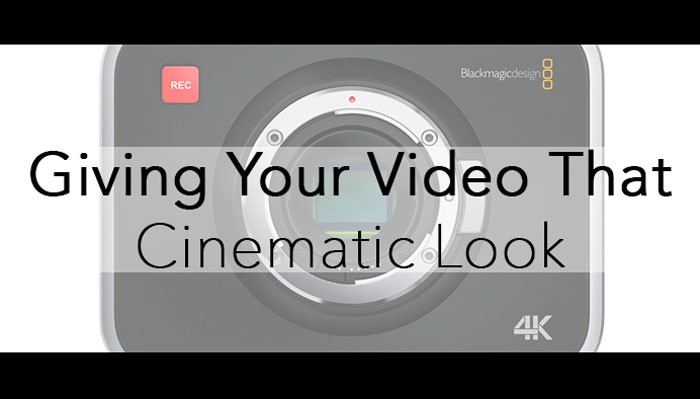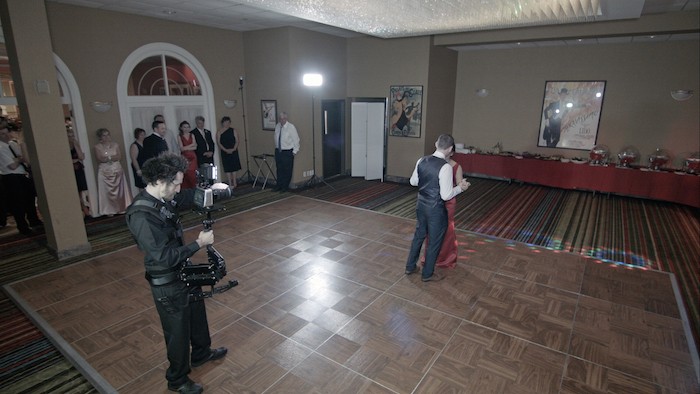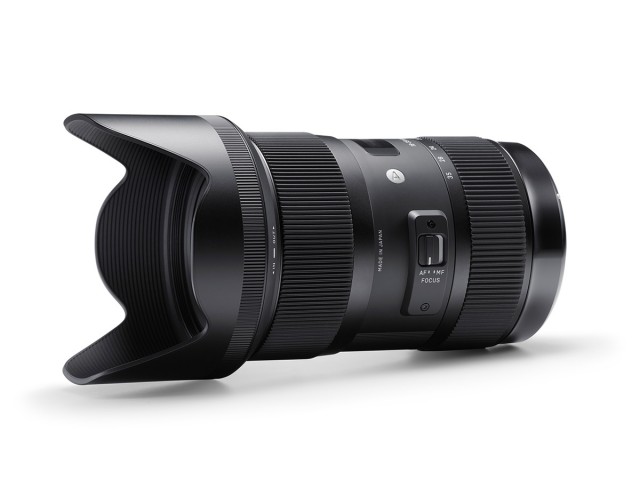
This article on Giving Your Video That Cinematic Look – Why Understanding ISO Is Just as Important as Having the Right Gear is from guest author Corey Benoit.
From Still to Motion
Like many, my projects require both still and motion images and are often lacking essential light to simplify the production. Switching between the two, I have found that understanding ISO is equally as important as selecting the right gear for your shoot. This article takes a look at ISO and gear for creating cinematic video in low light situations.
The ISO Myth
Many photographers and videographers think that ISO only affects the overall exposure of the image or the light being received by the sensor, and this is a myth. ISO doesn’t just affect the exposure or the lightness/brightness of an image. It basically destroys the color integrity and accuracy. Your greens will take on a lighter shade and will most likely have noise. Reds turn into more of an orangey kind of red, and blues will typically take on a cyan color. Color pollution is a problem with higher ISO. The color matrix will be polluted the more you push the ISO. Not to mention the damage that is done to the black/gray shades. They are polluted very badly with higher ISO.
Dynamic range is also disturbed. Whenever you crank up the ISO, you heat up the sensor. This will make any light sources in your video appear much brighter and will create noise in those dark areas where you were trying to bring up the shadows. You can expect that for every stop of light you increase on your exposure with just ISO, you are losing a portion of that in dynamic range. For example, you are shooting a spot that has dark trees and shrubs but the sun’s exposure is high and ineffectively lighting the trees, which makes them appear darker or not visible. Let’s say to pull out the shadows you decide to turn up the ISO. The sky will blow out and the effectiveness of your camera’s dynamic range will decrease on a similar scale with the increased ISO. Not to mention that if you are shooting on a typical DSLR, there is no way to reduce the highlights because the information is simply not there to begin with.
You Need a Game Plan and the Right Gear

The first step in your game plan is defining the look you want to achieve. Like still photography cameras, each category of video camera has its own style. I shoot a lot of weddings, and my clients prefer to have that cinematic look for their video. While they work well in low light situations, the typical DSLR will not deliver that filmic look. For this you are better off using a digital film camera. For this article and examples, I am working with the Blackmagic Production Camera 4K, and for the record, I have used it for many wedding projects with great results.
With that said, using any digital film camera in low light situations requires a bit more effort. Yes, many of you will say that the DSLR cameras are easier to work with in low light situations. This is true, but it may not give you the look you and your clients want and at the end of the day, this is all that counts. Some investment and a good game plan are needed.
The second step is understanding the differences between working with ISO from camera to camera. Unlike a DSLR, when you increase the ISO (also referred to as ASA) in digital film cameras like the Blackmagic Production Camera 4K, you are not changing the voltage on the sensor. You are changing the metadata and shifting the gamma curve. If you increase the ISO, you push the gamma curve higher and ultimately shift the noise and black shades along with it.
This is where increasing ISO gets tricky on digital film cameras. Instead of increasing the sensitivity of a camera with the increase in ISO, which is the goal, you end up shifting the gamma curve for the gray and black levels up, making the blacks appear more gray colored and the whites appear whiter, or worse yet, blown out completely. The end result is an increase in noise and loss of dynamic range. To help overcome this, you need to use a faster lens or add light.
A Faster Lens Can Make the Difference
The right lens will alleviate a lot of the pain associated with digital film cameras and low light shooting. Many shooters believe shooting at f/2.8 is a fast enough aperture. However, it’s just not enough. This may blow some minds but think of this. Shooting at f/1.4 gives you four times the amount of light that a typical f/2.8 lens will achieve. Even shooting at f/2.0 will give you two times the amount of light over f/2.8. That’s a good amount of light that you are no longer losing.

For the Blackmagic Production Camera 4K I typically shoot with the Sigma 18-35mm f/1.8 lens. It gives the digital film camera sensor more than twice the amount of light of a typical f/2.8 lens. Since these cameras offer higher megapixel counts, they need more light. This is due to pixel density (a topic for another day, look into it), which is extremely important to understand. Most lenses at f/2.0 are soft, especially if it’s the widest aperture on that lens. The Sigma 18-35mm f/1.8, like almost no other lens I have used, is sharp at f/2.0. It is even sharper when you stop it down.
Keep Your Distance
If you’re shooting at f/2.0 or below, you will want to check your distance. If you are shooting a wedding, you don’t want to be two or three feet away shooting at f/2.0. The depth of field will be too shallow and it will be challenging to focus in on your subjects face and eyes. Unless you have had practiced framing these type of shots, I don’t recommend shooting close ups below a f/2.0 as it can get really tricky. Step back and give yourself some room. I would say six-eight feet is a great start. Experiment. The depth of field will be deeper, allowing you to shoot at f/2.0 and get better low light and sharp images. This is the balance to using film cameras.
Yes, You Will Need Lights … For Almost Any Situation
In addition to the faster lens, you should consider investing in and using LED lights that are flicker free and can run on swappable batteries. If you are shooting at f/2.0, f/2.8 or even higher, I would suggest using an “on camera” LED light that has at least 900 LUX at three feet and also has a dimming dial or switch. Also note that all of these lights and tricks can be used on any shoot whether you are using a digital film camera or not. It’s just the best way to shoot digital film.
Understanding the ISO combined with a fast lens and decent set of lights will ensure that you see all of the details even in the dark background, be it Mom and Dad reveling in that special moment or friends and family dancing. Using a digital film camera gives you image quality where it matters most. Shadows and mid tones will roll off gently, allowing you to create that subtle film effect as opposed to a cheap home video look where the whole screen is bright or where there are very noisy shadows. The dynamic range and preserved information are far superior.
We Are Really Drawing with Light
The word photography is Greek, and it means to draw with light. It’s the perfect statement. Think about this before cranking up the ISO. Like photography, videography is where we draw a moving image with light using light to counter the darkness. So in certain situations, ISO might be a challenge but it’s not a limit. All dark situations, even those where you cannot crank up the ISO, can be fixed with light.
Don’t Hit Your Head on the Ceiling:
Typically when you clip on your Histogram, it will go all the way to the top and flat line. I back off a little bit so it’s no longer flat lining or clipping on the top of the actual diagram. It’s really simple with Blackmagic’s Histogram feature because the meter and the highlight area are about as accurate as you can get.
Break Free of the ISO Curse:
Many think that ISO only affects the overall exposure of the image or whether or not the sensor is receiving the light, and this is a myth. ISO doesn’t just affect the exposure or the brightness of an image. It helps destroy the color integrity and accuracy. Learn to use ISO like a tool, not a crutch. Use lights, fast lenses and get the image you want properly.
Kill the Darkness with Light and Fast Lenses:
Dark rooms are not a limit, just a simple challenge that we can overcome. In film cameras like the Blackmagic Production Camera 4K, changing ISO/ASA doesn’t just change the exposure. It shifts the gamma curve. Instead, use faster lenses and light. This will give you deep colors, film contrast and low noise floor.
It’s All in the Name of this Game:
The word photography is Greek, and it means to draw with light. The word graphy literally means to light. Therefore, videography is the same thing just with moving images. Next time before cranking the ISO/ASA reach for some light and paint the image you want. You are the artist, you create the light and you paint the picture.
Corey Benoit is a wedding & event photographer and videographer in the NYC/NJ area. You can learn more about Corey and see his work at www.faymusmedia.com.
Copyright/DMCA Notice: The RSS entry was originally published on Photography Bay. RSSID#794326